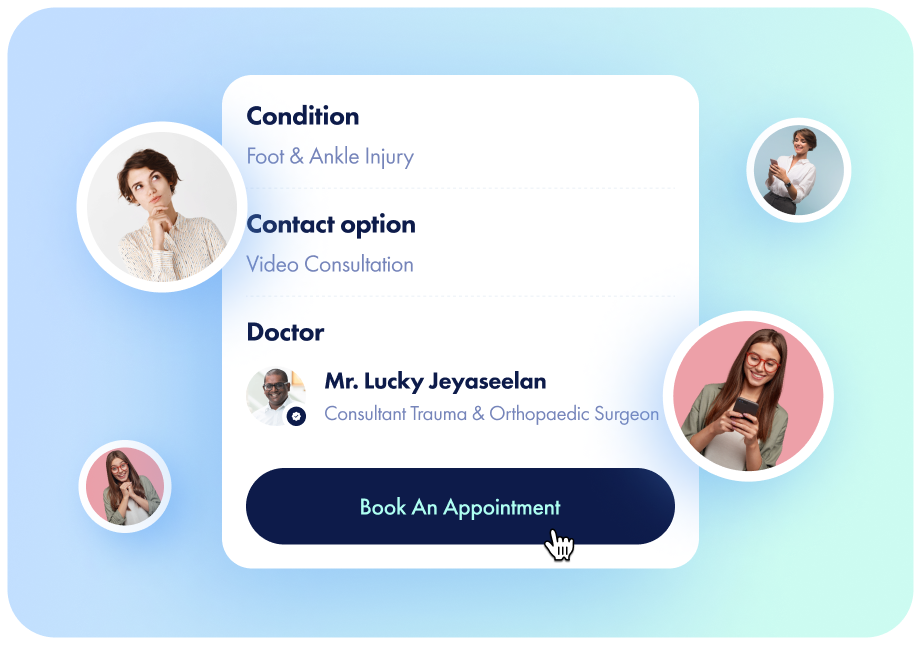
Conveniently reserve your spot with just a few clicks through our easy-to-use online booking system.


Running injuries can arise from overuse, improper training techniques, muscle imbalances, or worn-out shoes. Common injuries include shin splints, stress fractures, tendonitis, and runner's knee.
You are not required to provide a referral letter from your doctor or GP.
Start a visit quickly and discreetly whenever works best for you.
Our doctors review symptoms, prescribe treatments if needed.
Proceed with your healthcare journey as you wish. You're in control.
You control medical records, access anytime.
When you're hitting the pavement regularly, some factors can increase your chances of getting hurt. Here's what to watch out for:
Going too hard or too long before your body's ready can invite injury.
If some muscles are weaker than others, you might be setting the stage for a strain.
Your style matters. Running awkwardly, especially on rough terrain, can cause problems.
Too few steps means longer leaps and a higher chance of injury.
Old shoes don't cushion your feet well, upping injury risks.
Your body needs downtime to repair and strengthen.
Remember, multiple factors can gang up to cause harm, but often, a past injury is what puts you at most risk. Avoiding that first injury is paramount. Why? Because overuse is the number one cause of most running injuries. Taking care of your body by pacing yourself, wearing the right gear, and resting can help keep you on track and out of the doctor's office.
Сontact us to schedule an appointment or learn more
Conveniently reserve your spot with just a few clicks through our easy-to-use online booking system.
Have a question or request? Drop us a message, and our team will get back to you promptly.
Feel free to give us a call, and our friendly staff will be glad to assist you over the phone.
Got a nagging pain after your run? Here's the lowdown on the usual suspects when it comes to runner's woes:
Ever feel an ache in the front of your knee or around the kneecap after a run? That's likely runner's knee. It's what we call an overuse injury, and it's common if your sports shoes no longer provide the support and cushioning you need.
If your hips or surrounding knee muscles are on the weaker side, you might be more prone to this too.
Runner's knee pain often feels like a persistent, dull ache that could affect either one or both knees. The discomfort might range from a tolerable mild ache to an intense pain that makes you wince. It's the kind of pain that worsens after sitting for a long period or during an exercise session. Activities like jumping, climbing stairs, or squatting can intensify the discomfort.
If you hear your knee making snap, crackle, and pop sounds when you stand up, that's another clue.
Your doctor will usually diagnose runner's knee with just a check-up. But sometimes, they'll want an X-ray to be sure it's not something else. If it is runner's knee, a physical therapist can help with treatment, setting up a game plan to get you back in stride.
A stress fracture is a small, irritating crack in a bone, most commonly afflicting runners in the shin and foot areas. It's what happens when you demand too much from your body without allowing it adequate time to adapt to new activities.
The pain associated with a stress fracture typically intensifies with continued activity and diminishes during rest periods. Ignoring this pain and continuing to stress the affected bone can lead to a more severe injury, which inevitably prolongs recovery time.
Shin splints—medically known as medial tibial stress syndrome—present as a persistent ache along the shinbone and are a frequent complaint following a sudden increase in exercise intensity or duration.
Unlike the localised pain of a stress fracture, the discomfort from shin splints tends to be distributed over a larger area along the shinbone. While an X-ray can confirm a stress fracture, it usually appears normal for shin splints, which are particularly common among individuals with flatter feet.
To mitigate the discomfort of shin splints and encourage recovery, consider the following steps:
Temporarily reducing your running distance can significantly alleviate the strain on your shins, allowing the affected tissues to recover.
Slowing down your running pace can reduce the impact on your shins, offering them relief and a chance to heal properly.
Regular stretching exercises can improve muscle flexibility, which can help reduce the stress on your shins. Gentle, consistent stretching is vital to managing and preventing the recurrence of shin splints.
By carefully moderating activity and focusing on recovery strategies, you can manage shin splints effectively and return to your running regimen with greater resilience.
Achilles tendinitis happens when the tendon linking your calf to your heel gets inflamed. It's often the result of stepping up your running game too fast in terms of speed or distance.
When ignored, this inflammation can lead to a tear in your Achilles tendon—a painful scenario that might land you in surgery.
Signs that you're dealing with Achilles tendinitis include the following:
A persistent ache just above your heel
Swelling that you can see around the tendon area
Stiffness in your foot, especially noticeable when pointing your toes up
Warmth over the affected tendon
Your IT band is a vital piece of connective tissue that runs along the outside of your leg from hip to knee. This band of tissue is crucial for stabilising the knee during activity.
Sharp, focused pain on the outer side of the leg, near the knee
A feeling of tenderness when you touch the IT band
Worsening pain when bending the knee, often during a run or even a walk
The IT band being too tight from excessive running
Weak muscles around your hips or core that don't correctly support your legs
Continual friction from the IT band moving over the leg bone during repetitive motion
The hamstring muscles are crucial in slowing down your lower leg every time it swings forward during your run. If these muscles are tight, not strong enough, or simply worn out, they're at a higher risk of getting hurt.
Distance runners don't often face abrupt hamstring injuries like sprinters do. Instead, they might deal with gradual strains. These strains are like whispers of warning—the result of tiny, repeated tears in the muscle fibres and the tissue around them.
Feeling a dull ache at the back of your thigh? Is that area sensitive when you press it, or does your hamstring feel like it's lost some of its strength and flexibility? These can be tell-tale signs that you've strained your hamstring.
A muscle pull is essentially a tiny rip in your muscle—what you'd call a muscle strain. Imagine stretching an elastic band too far; that's similar to what happens when you overstretch a muscle. Sometimes, it's accompanied by a distinct pop the moment the muscle fibres tear.
The classic response to a muscle pull is what's known as RICE: give yourself some rest, use ice to bring down the swelling, wrap it up for compression, and keep it elevated.
Muscle pulls can happen to several muscle groups, especially those you rely on most during your runs:
Hamstrings, which help control the power and movement of your stride
Quadriceps, the front-facing thigh muscles that keep your knees steady and absorb the impact of your footfall
Calves, which propel you forward with each step
Groin, which is crucial for stabilising your side-to-side movements
An ankle sprain happens when the ligaments around your ankle get overstretched or torn, usually because of a twist or a wrong step that forces the foot inward. It's a common mishap that can occur during a run or any active movement.
When you sprain your ankle, the healing toolkit also includes the RICE protocol:
Taking it easy (rest)
Cooling the area (ice)
Wrapping it snugly (compression)
Keeping your foot up high (elevation)
If you sprain your ankle, you might observe some changes and feel certain discomforts. The affected area could show signs of discolouration or bruising, a clear indicator of injury beneath the skin. When you try to move your ankle or apply pressure to it, you're likely to experience pain.
Swelling may also be evident, giving your ankle a puffed-up appearance. Additionally, you could find that your ankle has lost its usual flexibility, feeling stiff and resistant to movement.
Ankle sprains typically get better on their own with some care and patience. While mild sprains might need a bit of TLC at home, others benefit from a physical therapist's guidance. Recovery time can range from a few weeks to a few months.
Dealing with pain in your foot, especially under the heel or the mid-foot area? You might be facing plantar fasciitis, a common running injury.
Plantar fasciitis develops when the fascia, a tough band under your foot that works like a shock-absorbing bowstring, gets irritated or starts to break down.
Why does this happen? It could be from increasing the intensity of your runs too fast, giving the fascia more stretch and stress than it can handle. Or maybe your calf muscles are tight or not strong enough, which puts extra strain on your foot.
People with plantar fasciitis usually feel:
A sharp pain right under the heel or along the mid-foot
A slow build-up of pain over time, not sudden
A stinging or burning feeling under the foot
The worst pain first thing in the morning or after you've been still for a while
Discomfort that gets more noticeable after you finish a run or if you've been on your feet a lot
Treating plantar fasciitis involves easing up on your feet, stretching properly, and sometimes using special supports in your shoes to relieve the stress on the fascia.
From Home or Face to Face, all at your convenience
Schedule a Video Consultation or a Face-to-Face appointment at your convenience by using our online booking system.
Speak with a Specialist
Schedule a Video Consultation or a Face-to-Face appointment at your convenience by using our online booking system.
Get a Personalised Treatment Plan
Your dedicated Specialist Doctor will provide you with personalized treatment, tailoring it to your specific needs, and may include necessary medication.
Runners often face a variety of injuries beyond the usual muscle strains and joint issues. Here are a few to watch out for:
This problem happens when your nail grows into the surrounding skin, leading to soreness and sometimes an infection signalled by redness and pus.
Your joints have small, fluid-filled pads called bursae that cushion them. Too much running can rub these the wrong way, causing pain around your hips or knees.
Inside your knee, there's cartilage that can tear, making your knee feel like it's caught or locked up when you move.
These little bubbles of skin fill with fluid and are caused by your shoe or sock rubbing up against your skin too much. To keep blisters at bay:
Ease into wearing new shoes.
Opt for socks with an extra layer of protection.
Slather on some petroleum jelly.
Running under the blazing sun or in frosty conditions can bring its own set of risks:
Sunburn can be sneaky, so slap on that sunscreen.
Heat exhaustion can sneak up on you, so keep up your fluid intake.
Frostbite and hypothermia are cold-weather risks. Wear layers and protect your extremities to stay warm.
Our facilities are regularly inspected to ensure compliance with the highest industry standards.
Quick access to parking and
public transport
Helpful, accommodating staff
Comfortable and
calming environment























